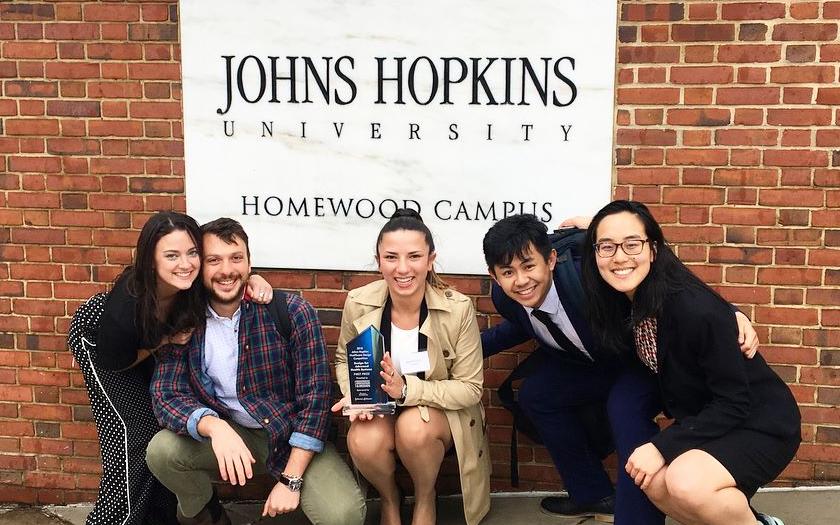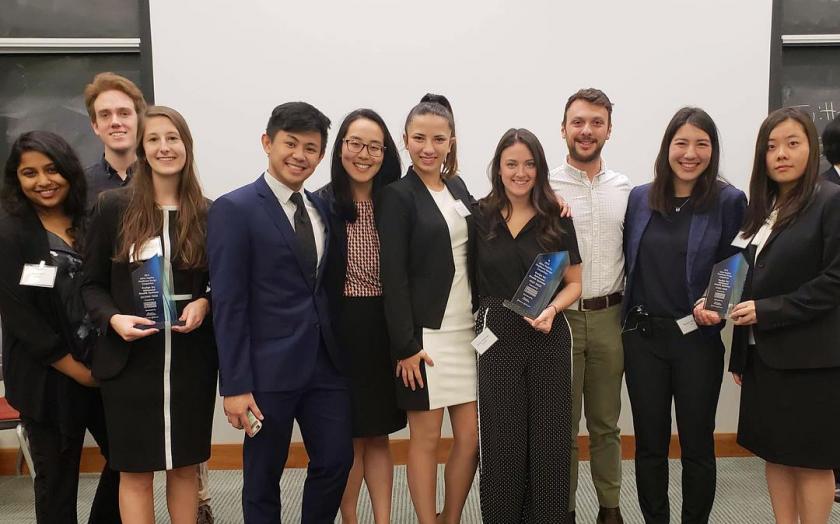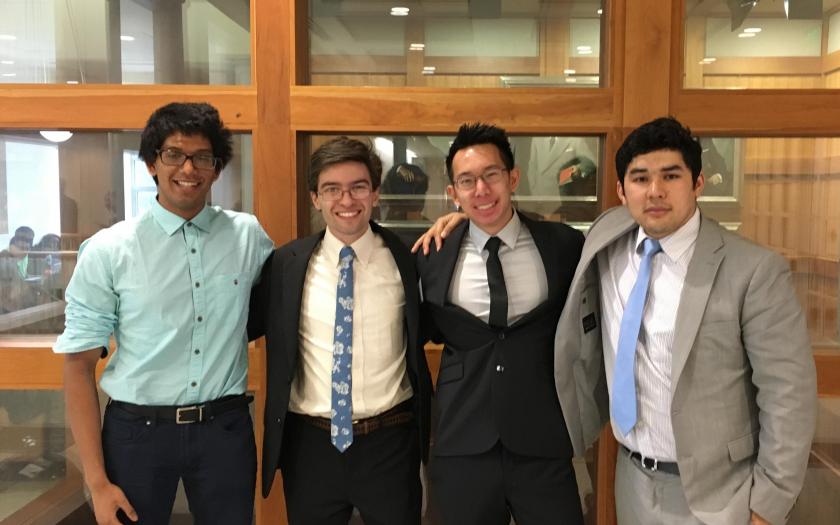Brown-RISD Team Wins First Prize at International Johns Hopkins Healthcare Design Competition
Brown & Biomedical Design
After recently completing capstone projects this past Fall, several groups of undergraduate seniors concentrating in biomedical engineering attended regional and international design competitions to continue advancing their ideas towards the patients they hope to benefit. The Biomedical Engineering Capstone (ENGN 1930L), a required course for all concentrators, encourages students to innovate across various medical fields. Dr. Celinda Kofron, Associate Director of the Center for Biomedical Engineering, and Dr. Anubhav Tripathi, Professor of Engineering, radically redesigned the capstone course two years ago to place greater emphasis on aligning students directly with clinical advisors who have identified significant clinical needs in their practices and this year cross-listed the course to allow for participation and collaboration of non-engineering concentrators and Rhode Island School of Design (RISD) students. With recent success at design competitions and several groups pursuing commercialization, this dramatic shift towards innovation in the senior capstone course already seems to be encouraging more meaningful and impactful student projects. “I came to academia with an industrial lens, and I recognized the need to integrate opportunities for students to bring their own innovations to the table,” said Dr. Tripathi. “Students, especially in Engineering, should not only be tested on existing academic material, but they should be given a chance to think in new ways and to generate solutions to real needs.” In Dr. Tripathi and Dr. Kofron’s vision, this need-driven model fosters sound engineering design by helping students craft solutions to existing, unmet needs rather than fitting a clinical problem to pre-existing engineering ideas. They are excited to continue to develop this program to serve larger academic, clinical, and entrepreneurial audiences as it expands to two semesters.
Taking it a step further…
In line with the entrepreneurial spirit fostered throughout the Brown community, two BME capstone teams ventured beyond the classroom to further the scope and impact of their projects. The first team includes senior biomedical engineering students Owen Leary, Rohan Rastogi, Zakir Tahiry, and Noah Trac, and was advised by Dr. Wael Asaad MD, PhD, Neurosurgeon at Rhode Island Hospital, and Dr. Shane Lee PhD, Research Associate in the Department of Neuroscience. The team, named Mobius Neuromodulation, worked to develop a novel electrode placement catheter to enable the use of electrodes that permit enhanced signal acquisition and more precise current steering in deep brain stimulation (DBS). Their innovative design consists of a perforated, 1.8mm cannula made of silicon and steel designed to guide more complex electrodes to their clinical targets for DBS, a standard neurosurgical procedure used widely in movement disorders like Parkinson’s Disease and currently in clinical trials for Obsessive-Compulsive Disorder (OCD) and Alzheimer’s Disease. “DBS technology is undergoing rapid development for a growing number of neurological diseases, and our design overcomes a key challenge by reducing constraints on the ubiquitous connector hardware that terminates in the implanted electrodes. Combined with other technologies we are developing, we are hopeful that our device will help enable high-density recording and stimulation in closed loop DBS systems to provide precise therapeutic relief in a patient-specific manner,” says Dr. Lee.
The second team is the result of a fruitful collaboration between Brown Biomedical Engineering and RISD, Department of Textiles, and comprises of seniors Berke Buyukkuckak, Emily Holtzman (RISD, Textiles), Celina Hsieh, Gian Ignacio, and Ileana Pirozzi, advised by clinical mentor Dr. Neel Sodha MD, Cardiothoracic Surgeon and Director of Cardiovascular Intensive Care Unit at Lifespan Cardiovascular Institute. Inspired by the flaws in the current technological landscape of embolic protection devices, as identified through observation of cardiothoracic bypass surgeries, the team put forward their own, original solution. Embonet is the next generation of embolic protection devices, designed to comply with existing surgical procedures, to minimize the risk of cardiogenic strokes during cardiopulmonary bypass surgeries. “Our innovative design improves embolic capture and our compartmentalization of captured debris improves the rate of retention of potential emboli. Our device also conforms to the tortuous aortic anatomy thanks to its open architecture and reduces harmful sandblasting effects,” explains Pirozzi.
Encouraged by Dr. Kofron and Dr. Tripathi, who saw promising potential in the teams’ designs, Mobius joined EmboNet in applying to the Johns Hopkins Healthcare Design Competition after recently collecting first prize in the Image & Signal Acquisition category of the Northeast Bioengineering Conference (NEBEC), a regional competition at Drexel University in Philadelphia PA.
Well aware of the higher stakes at the Johns Hopkins international competition, the teams were both surprised and elated to receive the news that they had been selected as finalists in the same track, Design for Advanced Health Systems, and were invited for the pitch day at Johns Hopkins, in Baltimore, MD, on April 15th 2018.
Johns Hopkins Healthcare Design Competition
The Johns Hopkins Healthcare Design Competition is an annual design competition open to full-time graduate and undergraduate groups that encourages the teams to pitch designs to address major unresolved clinical needs, and to think about the necessary steps to move their ideas to commercialization. Hosted by Johns Hopkins Center for Biomedical Innovation & Design (CBID) in Baltimore, MD, the competition was open for the first time this year to teams from around the world, and attracted over 100 design proposals. Ten or fewer teams were ultimately selected as finalists in each of three categories: Healthcare Information Technology, Global Health, and Advanced Health Systems. Selected finalists hailed from 16 academic institutions from across three continents. Brown University was represented by both the Mobius and the EmboNet teams, in the Advanced Health Systems division. The competition benefited from corporate sponsorship by Johnson & Johnson and Boston Scientific, two major medical technology companies at the forefront of innovation in their field. Dr. Mark Boden PhD, Senior Research Fellow and Technology Scout for Boston Scientific, delivered remarks emphasizing the importance of student innovations to solving the healthcare design challenges of tomorrow. J&J Vice President and Global Head of R&D Strategy and Business Operations, Dr. Pavan Heda PhD, operated as one of the competition judges in the Advanced Health Systems category. Both industry representatives spent time speaking directly with student groups during breaks, providing valuable feedback from a unique depth of corporate experience. The event was facilitated by Dr. Kunal Parikh PhD, Founder and CEO of Kalyan Ventures and a Research Associate at Johns Hopkins, and Dr. Youseph Yazdi PhD, Executive Director of the CBID. Other judges at the Advanced Health Systems division included Dr. David O’Brien Coon MD, President and CMO of Sonavex, amongst an array of clinicians, engineers and serial entrepreneurs. This public event attracted other industry recruiters and technology scouts and served to provide a breadth of exposure to the medtech sphere.
The Pitch Day
As both teams flew from Providence to Baltimore the night before, pitch preparations continued late into the night. The capstone course at Brown prepared students well to proficiently deliver the technical details and quantitative testing underlying their designs, but this competition presented new challenges: students were asked to prepare business models and to address in their pitches the key market competition they would face on the path to commercialization. “Realizing how sophisticated some of the business models for other groups were likely to be, we were quite concerned by the significant emphasis we placed on the engineering design components of our device,” said Pirozzi. “As we told the judges, we are a team of scientists and designers after all, and hadn’t spent too much time considering how we would market EmboNet just yet.”
From months of quantitative analysis in capstone to working out last minute business pitch details, emphasis on engineering design eventually paid off. Competition day involved several sessions in which teams each delivered ten minute pitches, followed by ten minutes of questions from a panel of expert judges. Projects ranged from a new bone marrow extraction device for replacement therapy in blood cancers to a novel, more supportive neonatal transport device, and featured student presenters at various stages in their academic progression (including undergraduate, MBA, MD, and PhD candidates). After a long day of exciting design pitches and detailed back-and-forth between judges and presenters, winners in each category were announced to the whole group. In Advanced Health Systems, the third place winner was Z-Fib, a group that designed new pads for automated external defibrillators (AEDs) that largely overcome skin impedance during cardiopulmonary resuscitation, thereby dramatically reducing resuscitation time. In second place, team assistENT developed a nasal dilator designed to maximize airflow, comfort, and stability for patients with abnormal nasal septum anatomy. After enormous anticipation, the highest prize went to Brown’s EmboNet team, a reflection of the team’s combined strength in quantitative engineering design, clearly identified market need, and potential for real clinical impact. “The feedback we received was unexpectedly positive and encouraging,” posits Pirozzi. “We were told that we are drastically underselling our product, and that its clinical implications are far more impactful than we had originally anticipated. The judges were experts in their fields and their encouragement to pursue this project further for licensing purposes or to start a more serious business venture was truly invaluable”.
Major Takeaways
The student teams found the Hopkins competition to be an invaluable experience and are excited to share their major takeaways with the hopes that more students will take advantage of similar opportunities in future years. First of all, accurately anticipating the expectations of the audience should inform the points of emphasis for a project pitch. With respect to the JHU experience, the Brown teams were not aware of the extent and importance of business considerations in the context of the competition. “Other teams had fully developed business plans, considered profit projections, and pondered exit strategies. Some even had seed investments already. We initially thought this would be a serious deficiency, but eventually we realized that the judges were looking for sound, compelling engineering designs, and we decided to give it our best shot relying on the technical strengths of our ideas,” says Pirozzi.
Yet, the success of these two teams, despite their lack of training in business, doesn’t obviate the need for increasing undergraduate exposure to the financial aspects of medical technology commercialization. In fact, the students received valuable feedback about how crucial marketing experience can be in paving the way to a successful transition from the engineering lab to the clinic. Dr. Devin O’Brien Coon, MD, President and CMO of Sonavex, advised the EmboNet team to gain their own business skills, positing that modern engineers must be fluent in the language of business in response to the shortage of experienced business executives in comparison to the number of valuable engineering ideas. In today’s entrepreneurial ecosystem, where most start-ups end up being unsuccessful, a good place to start is defining a viable clinical marketspace to substantiate a sound engineering design.
The EmboNet team credits much of their success to their collaboration with team member Emily Holtzman (RISD, ‘18), who brought diverse, creative perspectives and served as an unique asset to the team, truly setting them apart amongst the deserving competition. Going forward, the teams hope that this success story inspires more Brown students to get involved in exciting ventures and take their projects beyond the classroom. “This year Brown teams had a 100% acceptance rate to the finalists rounds for both the regional NEBEC conference and the international Hopkins competition,” says Leary, “highlighting the aptitude that Brown students share for creative problem-solving. We hope that, taking advantage of the open curriculum, our fellow classmates will soon be able to explore complementary aspects of their engineering education, such as the design and commercialization processes, earlier in their undergraduate experience.” Both teams believe that this experience confirms Brown’s enormous potential as an entrepreneurial force in the medtech industry, and they encourage more structured collaborations between the classical engineering departments and neighboring Business, Economics and Organizations (BEO). “We would like to thank the staff at the Brown Office of Industry Engagement and Commercial Venturing, for their unwavering support and mentorship throughout these unpaved paths. We all look forward to developing these ideas further in the near future”, concluded Leary and Pirozzi.
The EmboNet team (genuinely startled at their victory) carried away from the competition a $4000 prize, valuable experience from their first corporate exposure, and first-hand evidence that the new capstone design curriculum, engineered by Drs. Tripathi and Kofron, is a fruitful endeavor; for the School of Engineering and the Division of Biology and Medicine, for budding student entrepreneurs, and, hopefully, for patients.


